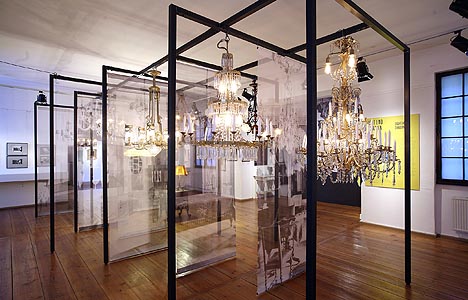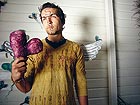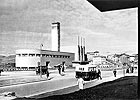
translated and summarized by: Liz Wollner-Grandville,
English summary October 27 - November 2
Märkisches Museum / Stadtmuseum Berlin: Berlin in the light
Wotan and the incandescent mantle
The exhibit “Berlin in the light” at the Märkische Museum offers a fabulous overview of how lighting accentuates a modern metropolis. Among the more than 1.400 objects displayed visitors have the rare opportunity to see original incandescent gas light mantles, “Wotan” and “Auer-glow lamps” dating back to the days of transformer stations and large gasometers, neon chandeliers (1920) once installed at the Shell house, electric water kettles designed by Peter Behrens, advertisement posters for the German public utility company AEG (Allgemeine Elektrizitätsgesellschaft), and Edvard Munch’s portrait of the young Walter Rathenau, son of the AEG boss, and who was later Germany’s foreign minister. Photo series depict scenes about the everyday life of Berlin lamp factory employees, as well as the plight of these workers, in their dingy and badly lit quarters.
The exhibit also deals with special topics focusing on the importance of lighting, without which life in a metropolis would be unthinkable: the legendary Berlin casinos and cabarets in the wild twenties, neon advertising, and backlit office facades. The exhibit spans from the Weimar Republic’s glamorous lighting to Albert Speer’s “Light Domes”, the blackout during the “Total war” - sadly succeeded by the gleaming lights mounted on the Berlin Wall.
Märkisches Museum / Stadtmuseum Berlin
10179 Berlin, Am Köllnischen Park 5, until 01.02. 09
www.stadtmuseum.de
Camera Austria: Elke Krystufek – Responsible for a certain amount of luck
Heading towards luck
Elke Krystufek is one of the few artists who directly deals with the motto of this year’s Steirischer Herbst “strategies to avoid misfortune” with her exhibit: “Responsible for a certain amount of luck”. The performative character of Krystufek’s photo collages, which are often perceived as an instruction to take action (and a strategy to avoid misfortune), is carried through the entire Camera Austria exhibit. The movable walls were set up like a maze or randomly positioned in the halls of Camera Austria, their structure becoming visible as a kind of backstage membrane. The names of those artists, whose work was exhibited in the past, such as Manfred Willmann, Seiichi Furuya or Swetlana Heger , are written on these walls with adhesive letters, which are, however, partly misspelled. Krystufek’s artistic oeuvre can be seen throughout the entire exhibit in the form of photographs mounted on the walls, confronted with the word “God” in different languages.
“Responsible for a certain amount of luck” can be perceived as a photographic documentation of Krystufek’s work over the past years. By listing (on the walls) the number of those works, which had either been lost, never delivered, or damaged by her former Vienna-based gallery, Krystufek vents her dissatisfaction. Her latest book titled “No”, published on the occasion of this exhibit, also refers to this situation. It contains texts, which introduce the reader to the artist’s universe. The movie “A Film Called Wood”, which is shown for the first time in Austria, also underlines the meaning of this universe. It intensifies Krystufek’s gender political approach by repeatedly referring to authors such as Virginia Woolf and Elfriede Jelinek.
This is definitely one of the most exciting presentations within this year’s programme of the Steirische Herbst and a foretaste of the upcoming Venice Biennale.
Camera Austria
8020 Graz, Kunsthaus Graz, Lendkai 1, until 11.01.09
www.camera-austria.at
Wien Museum Karlsplatz: Modern Turkey – Photographs by Othmar Pferschy
Modernism on the banks of the Bosporus
During the 1930’s it was fashionable for Austrians to immigrate to Turkey, which was at that time under the rule of Kemal Ataturk. Among them was Clemens Holzmeister, who designed numerous ministries, the parliament, and Ataturk’s palace in Ankara.
And the photographer Othmar Pferschy was another famous Austrian who had moved to Turkey. His works are currently shown at the Wien Museum. Due to the fact that the exhibit had originally been assembled for a Turkish audience, there is practically no reference to the difficult conditions under which a photographer from a foreign country was forced to work in Turkey. The Turkish state owned press office commissioned Pferschy to document the country’s new construction. Pferschy had moved from Graz to Istanbul in 1926. His photographs are published in numerous books as well as photo features. Pferschy was highly esteemed in Turkey; his photos were not only used for postcards, but also printed onto banknotes.
Pferschy’s carefully composed photographs shown at the Wien Museum depict Turkish middle school girls with short hair, female athletes in mini skirts, or beardless young Turkish students. These pictures could have easily been taken in Paris or Milan. While Holzmeister remained in exile in Turkey after 1938, Pferschy had to join the German Wehrmacht. He moved back to Turkey after 1947. However, the political climate had changed dramatically after Ataturk’s death, and on account of massive defamation campaigns by his colleagues, Pferschy dispiritedly left the country in 1969. Today, presumably many of the granddaughters of those depicted on Pferschy’s photographs, again wear headscarves.
Wien Museum Karlsplatz
1040 Wien, Karlsplatz, until 09.11.08
www.wienmuseum.at
Schlossmuseum Linz: Culture capital of the Führer – Art and National Socialism in Linz and Upper Austria
Model versus accusation
Hitler’s megalomaniac plans for the so-called “Führerstadt” Linz were the basis on which the Landesmuseum organized the huge exhibit “Culture Capital of the Führer”. Linz has been nominated as the European Culture Capital 2009.
The complex but not overloaded exhibit, curated by Birgit Kirchmayer, highlights areas of fine arts as well as theatre, music, and literature.
Hitler already fantasized about city planning during his adolescent years in Linz. The facsimiles of some of these early designs as well as his later drawings, in which his reactionary artistry was already evident, are part of the exhibit. CAD visualisations and quotes by Albert Speer and Hans Posse are presented and the Landesmuseum’s “own historical background” is dealt with in great detail. This is the kind of research one would wish other museums to dwell on in more depth.
The remoter areas of the exhibit are rather dusty; mainly due to the material shown: unsavoury blood and soil paintings, the then popular farming life scenes or turgid nude paintings, contrast with the harmless landscapes or abstract art by Herbert Bayer and others. Although the explanatory texts are informative, a more differentiated approach would have been appropriate.
The displayed theatre costumes – for example those for the “Meistersinger”- are musty, also in the olfactory sense of the word. The theatre programs prove how omnipresent the ideological atmosphere of regime was. Every programme included portraits of Hitler and Goebbels as well as their quotes.
Without this exhibit Linz would probably have been accused of not sufficiently dealing with its history. And even if the topic is dealt with rather late, it is done in an exemplary way.
Schlossmuseum Linz
4010 Linz, Tummelplatz 10, until 22.03.09
www.schlossmuseum.at
Mehr Texte von translated and summarized by: Liz Wollner-Grandville


 Teilen
Teilen





